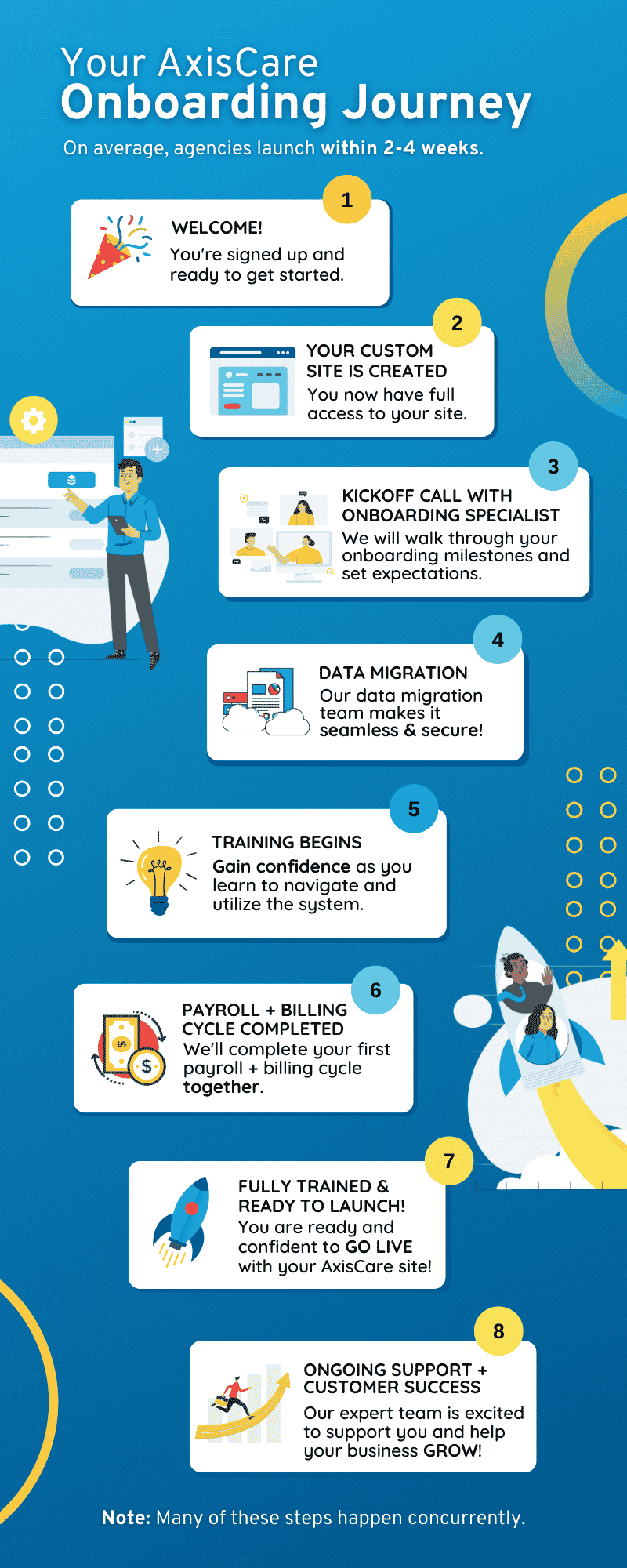There’s more to look forward to in 2021 than simply the fact that 2020 has reached its end.
In fact, 2021 is looking very promising for home care agencies due to an upward trend in demand for in-home care. Recent statistics in home care shed light on the end of the dark tunnel—and it makes sense why.
Economic recessions and setbacks are often followed by recovery and growth. With a vaccine that has already reached millions, there is hope that businesses and personal lives, even if somewhat altered, will resume.
Yes, home care has been negatively impacted by the COVID crisis. Even so, the industry has still seen consistent growth throughout the past decade, and that growth is not forecasted to change.
According to The Home Care Benchmarking Study by Activated Insights, based on the number of new providers who have started businesses, the industry has grown 44% in the last 5 years. Coupled with positive changes that the pandemic has encouraged within home care, 2021 is leaving ample room for optimism.

Here are 5 data-filled reasons why we expect the home care industry to skyrocket.
Reliable Home Care Market Growth
The United States is contending with a continually declining birth rate and an aging population. By 2034, there will be more adults over the age of 65 than children under the age of 18. Between 2018 and 2060, the population of seniors will have nearly doubled.
This, of course, is good news for POC healthcare and the home care industry.
The industry is already one of the fastest expanding industries in healthcare. Last year, U.S. home care spending reached an all-time high of $113.5 billion, and in 2021, there will be approximately 9,000 more home care agencies than there were 5 years ago.
The trends are unmistakable. Home care is not going anywhere and will only increase in necessity.
Even for home care agencies hard hit by COVID in 2020, there’s hope for consistency. The U.S. Department of Health and Human Services recently launched and expanded upon the CARES Act Provider Relief Fund.
Through the fund, providers can expect reimbursement of up to 88% of revenue loss—a much-needed jump start to the high-demand to come.
COVID-19 and a Further Shift to Home Care
Currently, hospitals have to save beds for the severely ill. They also strive to keep healthier patients away from COVID by asking those with non-essential needs to seek outside treatment. Therefore, a majority of patients must seek care at home or remotely.
According to Bill Dombi, President of the National Association of Home Care & Hospice:
“Homecare has distinguished itself in many ways during the pandemic. Caregivers of all disciplines have really stepped up to the frontlines of caring for COVID-19 infected patients while continuing the [sic] serve the millions of others who benefit from home care annually. In addition, through significant media coverage, increased awareness of the value of homecare has emerged in terms of safety, clinical efficacy, convenience, and the breadth of services. That awareness has grown in both consumers and the health care community (HomeCare Magazine).”
In support of this statement, a survey conducted by Transcend Strategy found that “65% of respondents said COVID-19 completely changed their opinions about the best way to care for aging seniors.” The survey concluded that “67% plan to use in-home care as a substitute for in-facility care even after the pandemic.”
Additionally, the National Center for Biotechnology Information states: “When asked about their care preferences, older Americans overwhelmingly articulate a desire to age in place and receive care at home rather than in institutional settings.”
While the extreme streamlining of hospital patients will eventually subside, the number of people who prefer in-home care (either through affordability, safety, convenience, or quality of care) is likely to remain.
After all, as the pandemic slowly stifles, a hasty return to hospitals and skilled nursing care no longer seems advantageous or even desirable.
Thankfully, receiving care in the comfort of one’s own home is no longer an anomaly. It is likely to become the health industry’s top focus.
The Evolution of Home Care Through Technology
Home care softwares, like AxisCare, have empowered agencies to be more efficient and organized during a time when quality of care is more important than ever.
Technology has infiltrated everything—including otherwise non-technological jobs. Many caregivers already use scheduling and management software to log essential visit information and check schedules. This technological proficiency has helped keep operations fluid.
Moving forward, tech will become a more prominent and essential tool for home care agencies, for both quality of care and compliance to new rules and regulations.
According to Home Care Pulse’s COVID-19 Impact Survey, nearly half of agencies surveyed are interested in continuing visit formats and services they began to explore during COVID, which might include things like virtual visits, grocery drop-off only visits, and doorstep visits.
Technologies such as Telehealth, caregiver mobile apps, and robust scheduling and management softwares will play an important role in ensuring that these different types of care and services are possible and documented with accuracy.
The bottom line is that technology is safe, allows flexibility for both caregivers and patients, and is a positive, long-term advancement in the home care landscape.
Home Care Affordability
Home care services can sound expensive, but in most cases where 24/7 assistance isn’t a requirement, it’s the best, most affordable option.
Even more encouraging is the recent increase in home care and home health insurance coverage.
Thanks to an expansion of the Medicare Advantage program, home care will be available to over 4.3 million beneficiaries in 2021.
“Prior to 2019, non-medical home care agencies did not have a role in the Medicare Advantage landscape. After a variety of policy chances, they now have an opportunity to contract with MA plans through two major pathways”. (Home Health Care News)
This includes a 390 million increase in payment to home care agencies—encompassing telehealth services—from the U.S. Centers for Medicare and Medicaid Services (CMS).
In addition, The National Association of Home Care and Hospice, citing CMS, states that if home care “were expanded nationwide, Medicare savings from unnecessary hospitalizations would exceed $2 billion annually.”
Limited Nursing Homes
From the first outbreak in Washington State to countless others, the coronavirus has ravaged nursing homes. Now, its collateral damage is forcing massive shutdowns.
According to Modern Healthcare, “As many as 66% of nursing homes say they could close in 2021 due to COVID-19 costs…”
Theoretically, with the vaccine here and nursing home patients to be prioritized recipients, nursing homes will eventually recover.
But in the interim, likely to last the length of 2021, home care services will have the opportunity to fill the void.
This implicates not only growth but an immediate, massive demand in home care. And with home caregivers also on the shortlist for a vaccine, it’s the only option that is far less vulnerable than nursing homes and hospitals to current and future outbreaks.
A Bright Horizon
Despite the public health crisis of 2020—or, in fact, largely because of it—home care is widely recognized as safe and even mandatory quality care.
The statistics plainly show the industry on an increasingly promising trajectory.
It’s time for the home care industry to take heart, shake off the dust, and start planning for a busy and successful year ahead.









